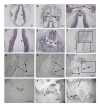Pathogenic variants in RNPC3 are associated with hypopituitarism and primary ovarian insufficiency
- PMID: 34906446
- PMCID: PMC7612377
- DOI: 10.1016/j.gim.2021.09.019
Pathogenic variants in RNPC3 are associated with hypopituitarism and primary ovarian insufficiency
Abstract
Purpose: We aimed to investigate the molecular basis underlying a novel phenotype including hypopituitarism associated with primary ovarian insufficiency.
Methods: We used next-generation sequencing to identify variants in all pedigrees. Expression of Rnpc3/RNPC3 was analyzed by in situ hybridization on murine/human embryonic sections. CRISPR/Cas9 was used to generate mice carrying the p.Leu483Phe pathogenic variant in the conserved murine Rnpc3 RRM2 domain.
Results: We described 15 patients from 9 pedigrees with biallelic pathogenic variants in RNPC3, encoding a specific protein component of the minor spliceosome, which is associated with a hypopituitary phenotype, including severe growth hormone (GH) deficiency, hypoprolactinemia, variable thyrotropin (also known as thyroid-stimulating hormone) deficiency, and anterior pituitary hypoplasia. Primary ovarian insufficiency was diagnosed in 8 of 9 affected females, whereas males had normal gonadal function. In addition, 2 affected males displayed normal growth when off GH treatment despite severe biochemical GH deficiency. In both mouse and human embryos, Rnpc3/RNPC3 was expressed in the developing forebrain, including the hypothalamus and Rathke's pouch. Female Rnpc3 mutant mice displayed a reduction in pituitary GH content but with no reproductive impairment in young mice. Male mice exhibited no obvious phenotype.
Conclusion: Our findings suggest novel insights into the role of RNPC3 in female-specific gonadal function and emphasize a critical role for the minor spliceosome in pituitary and ovarian development and function.
Keywords: Growth hormone deficiency; Hypopituitarism; Minor spliceosome; Primary ovarian insufficiency; U12-type spliceosome.
Copyright © 2021 American College of Medical Genetics and Genomics. All rights reserved.
Conflict of interest statement
Conflict of Interest All authors declare that they have no conflicts of interest.
Figures



References
Publication types
MeSH terms
Substances
Grants and funding
LinkOut - more resources
Full Text Sources
Medical
Molecular Biology Databases
Miscellaneous

